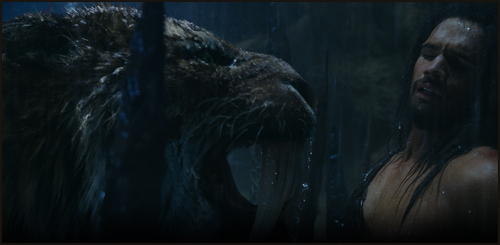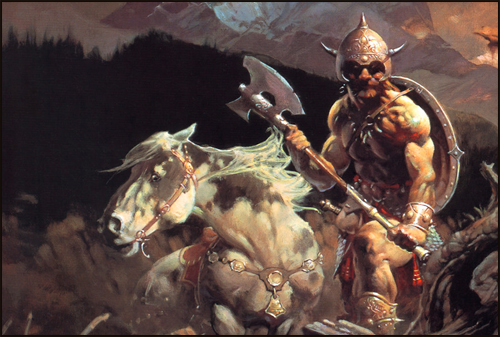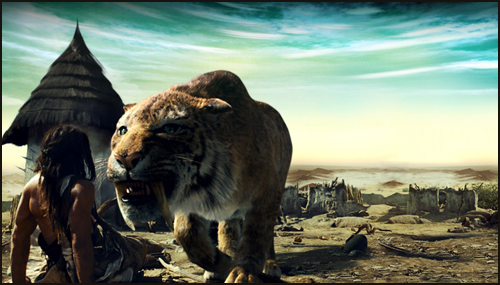Slay Cat Blues
Friday, February 29, 2008
posted by Steve Tompkins
 Print This Post
Print This Post

Great and terrible flesh-eating beasts have always shared landscape with humans. They were part of the ecological matrix within which Homo sapiens evolved. They were part of the psychological context in which our sense of destiny as a species arose. They were part of the spiritual systems that we invented for coping. The teeth of big predators, their claws, their ferocity and their hunger, were grim realities that could be eluded but not forgotten. Every once in a while, a monstrous carnivore emerged like doom from a forest or river to kill someone and feed on the body. It was a familiar sort of disaster–like auto fatalities today–that must have seemed freshly, shockingly gruesome each time, despite the familiarity. and it conveyed a certain message. Among the earliest forms of human self-awareness was the awareness of being meat.
That’s from David Quammen’s memorable-if-not-haunting 2003 Monster of God: The Man-Eating Predator in the Jungles of History and the Mind, a meditation on how “the alpha predators, and the responses they evoke, have transcended the physical dimension of sheer mortal struggle, finding their way also into mythology, art, epic literature, and religion.” One of the alpha-est predators, arguably the iconic carnivore of the Cenozoic Era, is figuring very prominently indeed in the trailers and promos for the March 7 release 10,000 B.C., directed by Roland Emmerich: Smilodon, the sabre-tooth tiger. Aficionados of Nature red in tooth and claw hope the film’s CGI and editing create charismatic killer cats that surpass Ray Harryhausen’s stop-motion sabre-tooth in Sinbad and the Eye of the Tiger and reclothe the animal in the dignity that was shed with the Denis Leary-voiced Diego in Ice Age and Ice Age 2. In honor of the occasion, I’d like to pay tribute to the two foremost mega-felines in all of modern fantasy, the gliding, pouncing juggernauts of Robert E. Howard’s “Beyond the Black River” and Karl Edward Wagner’s “Two Suns Setting.”
Am I overlooking a longtooth in Back to the Stone Age or one of the Pellucidar novels? Possibly, but any such Burroughsian tabby surely lacks the darkly fantastic, borderline horrific auras of the REH and KEW beasties:
The creature that stood in the gate was like the embodiment of nightmare legend. Its color was of a curious pale quality which made it seem ghostly and unreal in the dim light. But there was nothing unreal about the low-slung savage head, and the great curved fangs that glistened in the firelight. On noiseless padded feet it approached like a phantom out of the past. It was a survival of an older, grimmer age, the ogre of many an ancient legend–a saber-tooth tiger. No Hyborian hunter had looked upon one of those primordial brutes for centuries. Immemorial myths lent the creatures a supernatural quality, induced by their ghostly color and their fiendish ferocity.
Nightmare legend, ghostly and unreal, phantom out of the past, the ogre of many a legend, a supernatural quality–the cat conjured up by Zogar Sag, and by Robert E. Howard behind him, is almost as much of a revenant, a sojourner from elsewhen, as the dragon in “Red Nails.” The ensuing description reflects the notion, still prevalent in the paleontology books I devoured as a child, that Smilodon embodied the design flaw of overachievement, and was therefore a lethal culmination but also a cul-de-sac:
Its brain capacity was small. it had room for no instincts except those of destruction. it was a freak of carnivorous development; evolution run amuck in a horror of fangs and talons.
The Brits have an idiom, to big someone or something up. Howard capitalizes on the opportunity his onstage sabre-tooth gives him to big up both Zogar Sag and the story’s newly-minted mythology of Jhebbal Sag and the time before history when communication with the animal kingdom was instantaneous and innate (Just one example of how unobservant, how downright myopic it is to claim that he was running out of ideas by the end of the Conan series):
Balthus no longer doubted the actuality of the shaman’s magic. Only the black arts could establish a dominion over that tiny-brained, mightily-thewed monster. Like a whisper at the back of his consciousness rose the vague memory of the name of an ancient, ancient god of darkness and primordial fear, to whom once both men and beasts bowed, and whose children–men whispered–still lurked in dark corners of the world.
Zogar is not domiciled in a jewel-encrusted, dread-defended tower or temple, and has never read so much as a page of The Book of Skelos. But he can summon a sabre-tooth from out the vasty deep of Time, a creature whose grisly mystique Howard quickly reinforces: “He was no scavenger. He hunted only the living, in a life dedicated solely to slaughter. An awful hunger burned greenly in the wide, unwinking eyes; the hunger not alone of belly-emptiness, but the lust of death-dealing.”
Note that the cat’s eyes don’t just burn, they burn greenly. A perfectly simple and simply perfect adverb here, and Howard has performed the neat trick of converting Shakespeare’s green-eyed monster from a metaphor for jealousy into a live-and-literal green-eyed monster.
On Zogar’s cue the sabre-tooth inflicts one of the most spectacular deaths of the entire series on the Aquilonian forester tied to the stake next to that of Balthus, and then makes off with his victim. A deep roar from the blackness of the forest is the last we hear of, or from, him. His creator deserves all the praise in the world for not diminishing, not trivializing Old Green Eyes in a subsequent fight with Conan. The story offers encounters with more manageable cats, but with a tact and restraint that most of his imitators have lacked, Howard avoids pitting the Cimmerian against the “incarnated destruction” that loomed briefly but terribly in the village firelight. By way of contrast, Lin Carter’s Thongor kills off more megafauna than the end of the Cretaceous.

Karl Edward Wagner’s Kane stories are premeditated like few other heroic fantasies, and when Wagner decided to deploy a sabre-tooth in his 1975 “Two Suns Setting,” he would have been mindful of the star of Howard’s “Beyond the Black River” bestiary. Kane and his chance-met companion, the giant Dwasslir, are exploring the tomb of Brotemllain, a hero-king from the glory days of Dwasslir’s people. The burial site unluckily borders “a network of caves [that] bore through the mountains like the tortuous course of a feasting worm,” the denizens of which, lacking seasons and daylight, have “mutated to grotesque, primitive forms adapted to the demented savagery of their environment.” After this promising setup, Wagner delivers, as the sound of “a heavy body climbing over loose stone” and “two ruby coals throwing back the torchlight” announce the advent of his take on the biggest of cats:
Sabretooth! Or nightmare spawn of sabretooth tiger and Stygian darkness. The gargantuan creature that shambled forth from the timeless caverns of night was as demented a progeny of its natural forebears as were the other grotesque cave beasts Kane had seen. Rock crunched beneath taloned tread as it stalked from the gaping pit, an albino behemoth more than double the stature of its fearsome ancestor. Dripping jaws yawned hungrily in a cough of challenge–sabre-toothed jaws that could close upon Kane as a cat snaps up a rat.
Like Howard’s, Wagner’s cat is deathly white, but comes from Subterranea rather than Pictland, the caverns of Always-Night rather than the Abyss of Ages. Kane is alone with the supersized sabre-tooth, having been walled off from Dwasslir by a cave-in. He buys time by brandishing his torch, an affront to the animal’s darkness-adjusted vision, and then, in a wonderful touch, by winning a staredown: “…but Kane glared unwaveringly into the cat’s wrathful eyes. The tiger started, spat in sudden bafflement.”
When Dwasslir digs his way through to Kane, the lord of the underworld backs off, but is maddened by Dwasslir’s purposeful bravado: “My ancestors were your enemy! We fought your forebears in ages past and made necklaces for our women from your pretty fangs!”
A bit more of this and it is well past on between the hulking humanoid (only Steven R. Donaldson, with Saltheart Foamfollower, has come close to creating as interesting a modern fantasy giant as Dwasslir) and the ginormous feline. Previously injured and for once on the wrong end of a stature gap, Kane is sidelined throughout. At one point Dwasslir makes the tiger into his own prehistoric Evander Holyfield by tearing off an ear with his teeth, following up with howls, jeers, and “chanted snatches of ancient verse-sagas of his race.”
Finally and odds-defyingly, the giant snaps his enemy’s spine and spits “into its dying eyes.” But he himself is too frayed and flayed to live, and he lapses into a reverie of lost greatness while Kane, moved in spite of himself, places the crown of King Brotemllain on the head of this suitable, but irreplaceable, heir. “Two Suns Setting” is Dwasslir’s story, not Kane’s, and Wagner has the confidence to shift his antihero into elegist mode for the occasion. Kane stands no chance against the albino Smilodon even with his broadsword, but the giant dispatches the monster. Barely dispatches it, yes, but also barehandedly dispatches it.

For my money the hero of 10,000 B.C. already has one strike against him as a mammoth hunter (no mammoths were harmed during the making of “The Garden of Fear,” thank Ymir), and I wouldn’t mind were he to gibber in terror when eyeball-to-eyeball with a sabre-tooth. That’s unlikely to happen, but it certainly would be gratifying if the movie treated its longtooth characters, and its Groth-golka-esque phorusrhacid (phorusrhacid: “terror bird”) with the respect and appreciation the velociraptors got in The Lost World and Jurassic Park III.
